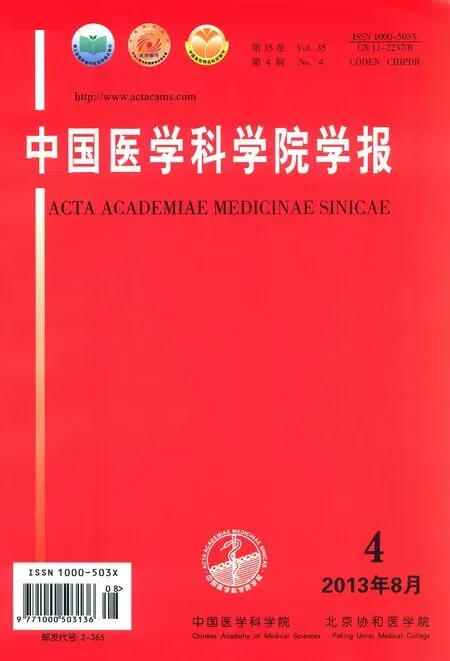肥胖症肠道菌群与炎症的研究进展
曹战江,于健春,康维明,马志强
中国医学科学院 北京协和医学院 北京协和医院基本外科,北京100730
肥胖症在全球范围内越来越普遍,已成为世界范围内重要的公共卫生问题。肥胖引起糖尿病、动脉硬化、脂肪肝、高脂血症等代谢综合征,影响着人们的健康及生活质量[1]。肥胖与现代的饮食及生活方式有关,能量摄取增加而消耗降低增加了脂肪的形成。在人体消化道内存在数量约1014的微生物,其基因组数量是人体的150倍以上[2]。肠道菌群在人类健康上发挥着比预想更重要的作用,在一定程度生影响着宿主的代谢与能量平衡。近年来,由于测序及分析技术的进步[3],有关肥胖、代谢综合征与肠道菌群关系的研究也取得了较大的进展,本文就肠道菌群在肥胖中的作用进行综述。
肥胖与肠道菌群改变
肠道菌群被认为是导致体重增加及能量代谢异常的环境因素。人及小鼠肠道菌群分类相似,大多数都可归为以下4类细菌:革兰阳性厚壁菌门、放线菌门,革兰阴性拟杆菌门、变形菌门。其中革兰阳性厚壁菌门和革兰阴性拟杆菌门占90%以上,瘦素缺失的肥胖小鼠与正常小鼠之间的肠道细菌不同,表现为革兰阴性拟杆菌门含量的降低及革兰阳性厚壁菌门含量的升高[4]。肠道完全无菌小鼠在给予高脂饮食后体重增加并不如肠道有菌小鼠那样明显,将有菌小鼠的盲肠细菌移植到无菌小鼠肠道后发现,原来肠道无菌小鼠显示出体重增加,肠道菌群在代谢及能量平衡非常重要,尤其是在高脂饮食导致的肥胖中起到中介作用[5]。不仅仅是动物实验中有这样的发现,Turnbaugh等[6]比较了12名肥胖志愿者与5名正常体重志愿者粪便中的细菌组成,结果显示肥胖者比瘦者多出约20%的革兰阳性厚壁菌门,同时又比瘦者少了约90%的革兰阴性拟杆菌门。给予肥胖志愿者低脂饮食1年后,其体重出现下降,而体内的革兰阳性厚壁菌门比例有了下降,革兰阴性拟杆菌门的比例则上升。虽然这两类细菌的比例水平尚未达到正常者体内两种细菌的比例,但该结果仍可说明肥胖与肠道内的细菌是相关的。胃旁路手术是目前治疗肥胖的有效方法,在手术后随着体重的下降、胰岛素抵抗的改善,还出现了革兰阳性厚壁菌门的下降及其他菌群的改变[7]。
然而,并非所有研究都支持这样的结果,有研究发现在肥胖者中有更低的革兰阳性厚壁菌门与革兰阴性拟杆菌门比率,肥胖者在减重过程中并没有出现革兰阴性拟杆菌门的改变[8-9]。虽然个体之间肠道菌群存在差异,但这提示肠道菌群并非依赖于肥胖状态,还可能与饮食之间有更为密切的关系。RELMβ基因敲除后不容易产生肥胖,无论是正常基因野生型小鼠还是RELMβ基因敲除小鼠,在高脂饮食条件下均可导致肠道菌群的改变[10]。饮食的改变,特别是普通饮食向高脂饮食改变时,会引起肠道微生态的改变[11]。
肠道菌群在肥胖发生过程中机制研究
肥胖是一种低度炎症反应。脂肪组织释放多种炎症因子,增加单核细胞在脂肪组织中的浸润,最终引起胰岛素抵抗等代谢并发症[12]。肥胖可导致血清炎症因子,如:C-反应蛋白 (C-reactive protein,CRP)、肿瘤坏死因子-α (tumor necrosis factor-α,TNF-α)和白细胞介素-6(interleukin-6,IL-6)等炎症因子的升高,也导致脂肪组织中炎症因子升高,特别是趋化因子单核细胞趋化蛋白1(monocyte chemoattractant protein-1,MCP-1)等,促进炎症细胞在脂肪中的浸润。炎症因子通过核因子 κB(nuclear factor-κB,NF-κB)等信号通路促进胰岛素信号通路胰岛素受体底物1(insulin receptor substrate1,IRS-1)磷酸化,促进胰岛素抵抗[13-15]。肠道也是合成大量炎症因子的器官。高脂饮食条件下,小鼠肠道内特别是中段小肠内发生一些与脂代谢、细胞周期及炎症免疫有关的分子改变,在尚未出现血清TNF-α升高的时候,肠道组织中特别是小肠组织中TNF-α已经出现升高[16]。肠道炎症成为肥胖早期的信号,提示引起代谢紊乱。
高脂饮食引起的肝脏、脂肪组织及血清中炎症因子增加,与血中脂多糖 (lipopoly-saccharide,LPS)升高有关[17]。有研究发现,无论是肥胖患者还是高脂饮食导致肥胖的小鼠模型中,血清LPS均高于正常对照[18]。肠黏膜屏障是肠道的生物屏障,可防止有害物质吸收入血。高脂饮食导致的肠道菌群改变可引起肠黏膜中紧密连接蛋白ZO-1、occludin变化,从而促进肠道通透性增加,损害肠黏膜屏障,导致LPS吸收入血[19]。LPS可促进脂肪组织中炎症细胞浸润及炎症因子表达[20]。已知LPS与Toll样受体4(Toll-like receptor 4,TLR4)结合可引发一系列炎症改变,而高脂饮食不能引起TLR4突变小鼠产生胰岛素抵抗及体重增加,这也能反映出LPS在高脂饮食引起肥胖中的作用[21]。肠道菌群产生的LPS在肥胖及代谢紊乱过程中发挥重要作用,肠道菌群改变通过产生LPS,降低肠黏膜通透性,促进LPS入血引发炎症反应,引发高脂饮食导致的肥胖。
在高脂饲料喂养下,无菌小鼠血脂、炎症因子、瘦素等均低于正常小鼠。虽然无菌小鼠与正常小鼠粪便中所含能量相似,但两者粪便脂肪含量有明显不同[22]。在相同饮食条件下,ob/ob小鼠 (Leptin缺失肥胖小鼠)可产生更多的体重及脂肪组织,其肠道菌群也不同于ob/+小鼠,经粪便排出的食物残渣中的能量也多于ob/+小鼠,肥胖小鼠的肠道菌群增加了肠道吸收热量的能力[23]。
肠道细菌还可以酵解纤维素产生短链脂肪酸 (shortchain fatty acid,SCFAs),包括醋酸盐、丙酸盐及丁酸盐,SCFAs在肥胖患者中可出现20%升高[24]。SCFAs是G蛋白偶联受体41(G-protein-coupled receptor 41,GPR 41)及GPR43的配体,这两个G蛋白偶联受体主要表达在肠道。GPR41-/-与GPR43-/-小鼠和基因正常同伴相比有更低的体重,能抵抗饮食导致的肥胖。激活GPRs可引起肽yy(peptide yy,Pyy)释放增加,Pyy抑制肠道蠕动及促进营养吸收。以上说明GPR41与GPR43在肠道菌群调节肥胖中起到关键作用[25-26]。肠道微生物将食物中为消化的多糖分解为单糖、SCFAs,并促进单糖及SCFAs在肠道内的吸收,减少小肠上皮脂蛋白脂肪酶 (lipoprotein lipase,LPL)抑制禁食诱导脂肪细胞因子 (fasting-induced adipocyte factor,Fiaf)的产生,导致脂肪细胞内三酰甘油的沉积。无菌小鼠脂肪及肝脏组织中腺苷酸活化蛋白激酶(AMP-activated protein kinase,AMPK)磷酸化的增加可能是胰岛素抵抗改善的机制[5]。
机体免疫状态对肠道微生物也有一定影响,TLR5-/-小鼠可出现高脂血症、高血压、胰岛素抵抗及肥胖,这些代谢改变伴随着肠道菌群的改变,将TLR5-/-小鼠肠道细菌移植至无菌小鼠肠道,出现肥胖及代谢紊乱[27]。Upadhyay等[28]研究发现,淋巴毒素缺失及正常小鼠在正常饮食条件下,两者肠道的菌群不同,缺失小鼠肠道分段丝状菌增加。喂养高脂饮食后,淋巴毒素缺失小鼠的体重低于正常小鼠,肠道微生物也发生改变,分段丝状菌增加。将淋巴毒素缺失及未缺失小鼠肠道菌群分别移植至正常无菌小鼠肠道内,在3周内淋巴毒素缺失受者体重增加量低于未缺失组受者,但3周后则体重逐渐无差异,推测这是因为受者肠道免疫功能正常,短期内不能清除分段丝状菌,随着时间延长,肠道菌群恢复正常。
改变肠道菌群对肥胖及代谢的影响
口服益生菌能改善肠道内的菌群紊乱。研究发现,在喂养高脂饲料的同时给予小鼠双歧杆菌能缓解高脂饮食引起的代谢改变,减少肠黏膜通透性,降低血清LPS及炎症因子纤溶酶原激活物抑制剂1(plasminogen activator inhibitor,PAI-1)、诱导型一氧化氮合酶 (inducible nitric oxide synthase,iNOS)、单核细胞趋化蛋白1(monocyte chemoattractant protein-1,MCP-1),促进肠道分泌胰高血糖素样肽1(glucagon-like peptide1,GLP-1)和GLP-2,GLP-2在益生菌促进肠黏膜屏障改变过程中发挥主要作用[29]。
有研究发现,在给小鼠喂养高脂饮食的同时给予氨苄西林、新霉素及甲硝唑,不仅可改变肠道微生物,而且给予抗生素的小鼠体重也低于单纯高脂饮食组,并降低了血中的LPS水平,减轻了TLR4激活导致的肝脏及脂肪组织中的炎症水平。增加了胰岛素敏感性,改善了肥胖引起的脂肪组织及肝脏中胰岛素抵抗[31]。
总之,肠道菌群作为环境因素,可与宿主相互作用,在肥胖中发挥重要作用,促进肠道、脂肪组织、肝脏的炎症,促进脂肪合成及三酰甘油在肝脏及脂肪组织中的沉积。肠道菌群在动物研究中已取得深入的进展,但在人体方面的研究还需更多探索。肠道菌群数量庞大,功能复杂,还有许多尚未发现的作用及机制,将来或许可以作为治疗肥胖的目标。
[1]Hotamisligil GS.Inflammation and metabolic disorders [J].Nature,2006,444(7121):860-867.
[2]Qin J,Li R,Raes J,et al.A human gut microbial gene catalogue established by metagenomic sequencing [J].Nature,2010,464(7285):59-65.
[3]Eckburg PB,Bik EM,Bernstein CN,et al.Diversity of the human intestinal microbial flora [J].Science,2005,308(5728):1635-1638.
[4]Ley RE,Bäckhed F,Turnbaugh P,et al.Obesity alters gut microbial ecology [J].Proc Natl Acad Sci USA,2005,102(31):11070-11075.
[5]Bäckhed F,Ding H,Wang T,et al.The gut microbiota as an environmental factor that regulates fat storage [J].Proc Natl Acad Sci USA,2004,101(44):15718-15723.
[6]Turnbaugh PJ,Ley RE,Gordon JI,et al.An obesity-associated gut microbiome with increased capacity for energy harvest[J].Nature,2006,444(7122):1027-1031.
[7]Zhang H,DiBaise JK,Zuccolo A,et al,Human gut microbiota in obesity and after gastric bypass [J].Proc Natl Acad Sci USA,2009,106(7):2365-2370.
[8]Schwiertz A,Taras D,Schäfer K,et al.Microbiota and SCFA in lean and overweight healthy subjects [J].Obesity,2010,18(1):190-195.
[9]Duncan SH,Lobley GE,Holtrop G,et al.Human colonic microbiota associated with diet,obesity and weight loss [J].Int J Obes(Lond),2008,32(11):1720-1724.
[10]Hildebrandt MA,Hoffmann C,Sherrill-Mix SA,et al.Highfat diet determines the composition of the murine gut microbiome independently of obesity [J].Gastroenterology,2009,137(5):1716-1724.
[11]Turnbaugh PJ,Bäckhed F,Fulton L,et al.Diet-induced obesity is linked to marked but reversible alterations in the mouse distal gut microbiome [J].Cell Host Microbe,2008,3(4):213-223.
[12]Kern PA,Ranganathan S,Li C,et al.Adipose tissue tumor necrosis factor and interleukin-6 expression in human obesity and insulin resistance [J].Am J Physiol Endocrinol Metab,2001,280(5):E745-E751.
[13]Tanti JF,Jager J.Cellular mechanisms of insulin resistance:role of stress-regulated serine kinases and insulin receptor substrates(IRS)serine phosphorylation [J].Curr Opin Pharmacol,2009,9(6):753-762.
[14]Maury E,Brichard SM.Adipokine dysregulation,adipose tissue inflammation and metabolic syndrome [J].Mol Cell Endocrinol,2010,314(1):1-16.
[15]Lebrun P,Van Obberghen E.SOCS proteins causing trouble in insulin action [J].Acta Physiol(Oxf),2008,192(1):29-36.
[16]Ding S,Chi MM,Scull BP,et al.High-fat diet:bacteria interactions promote intestinal inflammation,which precedes and correlates with obesity and insulin resistance in mouse[J].PLoS One,2010,5(8):e12191.
[17]Canip D,Amar J,Iglesias MA,et al.Metabolic endotoxemia initiates obesity and insulin resistance [J].Diabetes,2007,56(7):1761-1772.
[18]Ghanim H,Abuaysheh S,Sia CL,et al.Increase in plasma endotoxin concentrations and the expression of Toll-like receptors and suppressor of cytokine signaling-3 in mononuclear cells after a high-fat,high-carbohydrate meal:implications for insulin resistance [J].Diabetes Care,2009,32(12):2281-2287.
[19]Canip D,Bibiloni R,Knauf C,et al.Changes in gut microbiota control metabolic endotoxemia-induced inflammation in high-fat diet-induced obesity and diabetes in mice[J].Diabetes,2008,57(6):1470-1481.
[20]Caesar R,Reigstad CS,Bäckhed HK,et al.Gut-derived lipopolysaccharide augments adipose macrophage accumulation but is not essential for impaired glucose or insulin tolerance in mice [J].Gut,2012,61(12):1701-1707.
[21]Poggi M,Bastelica D,Gual P,et al.C3H/HeJ mice carrying a toll-like receptor 4 mutation are protected against the development of insulin resistance in white adipose tissue in response to a high-fat diet[J].Diabetologia,2007,50(6):1267-1276.
[22]Rabot S,Membrez M,Bruneau A,et al.Germ-free C57BL/6J mice are resistant to high-fat-diet-induced insulin resistance and have altered cholesterolmetabolism [J].FASEB J,2010,24(12):4948-4959.
[23]Turnbaugh PJ,Ley RE,Mahowald MA,et al.An obesityassociated gut microbiome with increased capacity for energy harvest[J].Nature,2006,444(7122):1027-1031.
[24]Schwiertz A,Taras D,Schäfer K,et al.Microbiota and SCFA in lean and overweight healthy subjects[J].Obesity(Silver Spring),2010,18(1):190-195.
[25]Bjursell M,Admyre T,Göransson M,et al.Improved glucose control and reduced body fat mass in free fatty acid receptor 2-deficient mice fed a high-fat diet[J].Am J Physiol Endocrinol Metab,2011,300(1):E211-E220.
[26]Samuel BS,Shaito A,Motoike T,et al.Effects of the gut microbiota on host adiposity are modulated by the short-chain fatty-acid binding G protein-coupled receptor,Gpr41 [J].Proc Natl Acad Sci USA,2008,105(43):16767-16772.
[27]Vijay-Kumar M,Aitken JD,Carvalho FA,et al.Metabolic syndrome and altered gut microbiota in mice lacking Toll-like receptor 5 [J].Science,2010,328(5975):228-231.
[28]Upadhyay V,Poroyko V,Kim TJ,et al.Lymphotoxin regulates commensal responses to enable diet-induced obesity[J].Nat Immunol,2012,13(10):947-953.
[29]Cani PD,Possemiers S,Van de Wiele T,et al.Changes in gut microbiota control inflammation in obese mice through a mechanism involving GLP-2-drivenimprovement of gut permeability [J].Gut,2009,58(8):1091-1103.
[30]Carvalho BM,Guadagnini D,Tsukumo DM,et al.Modulation of gut microbiota by antibiotics improves insulin signalling in high-fat fed mice [J].Diabetologia,2012,55(10):2823-2834.

